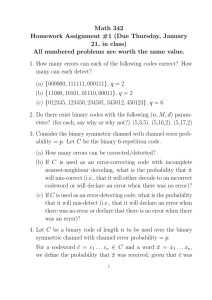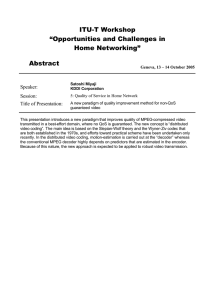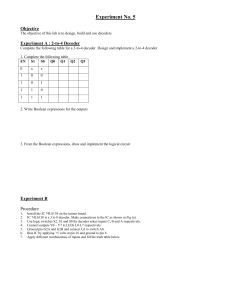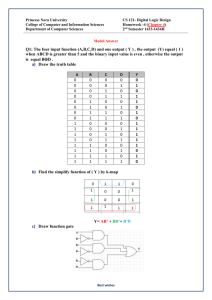Research Journal of Applied Sciences, Engineering and Technology 4(23): 5193-5200,... ISSN: 2040-7467
advertisement
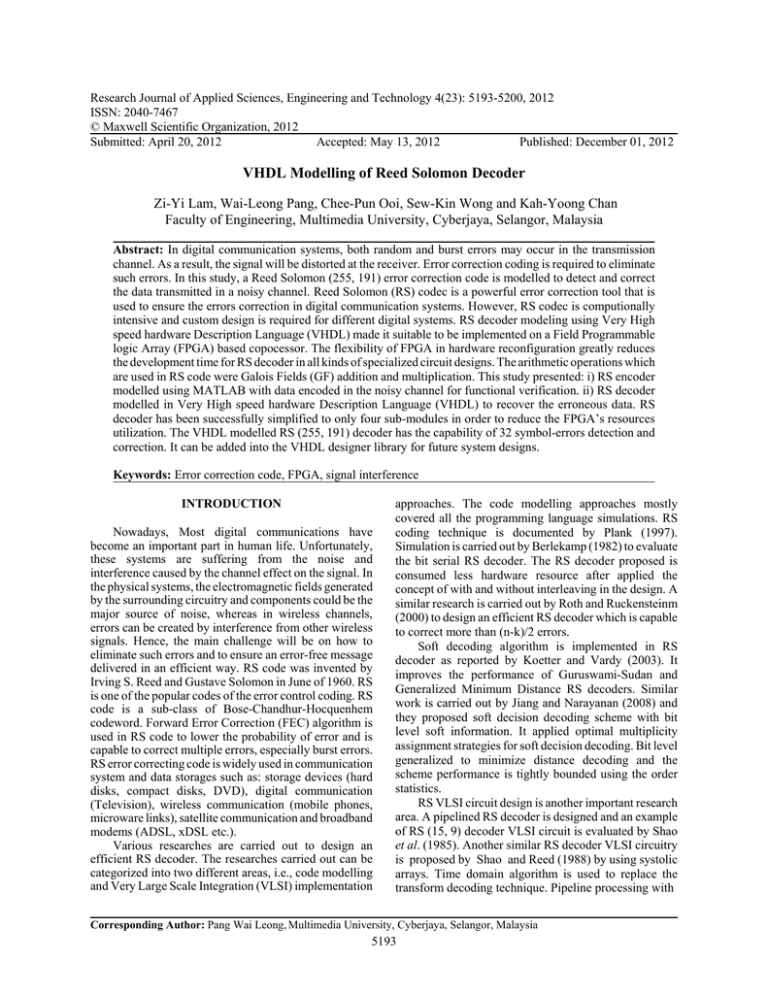
Research Journal of Applied Sciences, Engineering and Technology 4(23): 5193-5200, 2012 ISSN: 2040-7467 © Maxwell Scientific Organization, 2012 Submitted: April 20, 2012 Accepted: May 13, 2012 Published: December 01, 2012 VHDL Modelling of Reed Solomon Decoder Zi-Yi Lam, Wai-Leong Pang, Chee-Pun Ooi, Sew-Kin Wong and Kah-Yoong Chan Faculty of Engineering, Multimedia University, Cyberjaya, Selangor, Malaysia Abstract: In digital communication systems, both random and burst errors may occur in the transmission channel. As a result, the signal will be distorted at the receiver. Error correction coding is required to eliminate such errors. In this study, a Reed Solomon (255, 191) error correction code is modelled to detect and correct the data transmitted in a noisy channel. Reed Solomon (RS) codec is a powerful error correction tool that is used to ensure the errors correction in digital communication systems. However, RS codec is computionally intensive and custom design is required for different digital systems. RS decoder modeling using Very High speed hardware Description Language (VHDL) made it suitable to be implemented on a Field Programmable logic Array (FPGA) based copocessor. The flexibility of FPGA in hardware reconfiguration greatly reduces the development time for RS decoder in all kinds of specialized circuit designs. The arithmetic operations which are used in RS code were Galois Fields (GF) addition and multiplication. This study presented: i) RS encoder modelled using MATLAB with data encoded in the noisy channel for functional verification. ii) RS decoder modelled in Very High speed hardware Description Language (VHDL) to recover the erroneous data. RS decoder has been successfully simplified to only four sub-modules in order to reduce the FPGA’s resources utilization. The VHDL modelled RS (255, 191) decoder has the capability of 32 symbol-errors detection and correction. It can be added into the VHDL designer library for future system designs. Keywords: Error correction code, FPGA, signal interference INTRODUCTION Nowadays, Most digital communications have become an important part in human life. Unfortunately, these systems are suffering from the noise and interference caused by the channel effect on the signal. In the physical systems, the electromagnetic fields generated by the surrounding circuitry and components could be the major source of noise, whereas in wireless channels, errors can be created by interference from other wireless signals. Hence, the main challenge will be on how to eliminate such errors and to ensure an error-free message delivered in an efficient way. RS code was invented by Irving S. Reed and Gustave Solomon in June of 1960. RS is one of the popular codes of the error control coding. RS code is a sub-class of Bose-Chandhur-Hocquenhem codeword. Forward Error Correction (FEC) algorithm is used in RS code to lower the probability of error and is capable to correct multiple errors, especially burst errors. RS error correcting code is widely used in communication system and data storages such as: storage devices (hard disks, compact disks, DVD), digital communication (Television), wireless communication (mobile phones, microware links), satellite communication and broadband modems (ADSL, xDSL etc.). Various researches are carried out to design an efficient RS decoder. The researches carried out can be categorized into two different areas, i.e., code modelling and Very Large Scale Integration (VLSI) implementation approaches. The code modelling approaches mostly covered all the programming language simulations. RS coding technique is documented by Plank (1997). Simulation is carried out by Berlekamp (1982) to evaluate the bit serial RS decoder. The RS decoder proposed is consumed less hardware resource after applied the concept of with and without interleaving in the design. A similar research is carried out by Roth and Ruckensteinm (2000) to design an efficient RS decoder which is capable to correct more than (n-k)/2 errors. Soft decoding algorithm is implemented in RS decoder as reported by Koetter and Vardy (2003). It improves the performance of Guruswami-Sudan and Generalized Minimum Distance RS decoders. Similar work is carried out by Jiang and Narayanan (2008) and they proposed soft decision decoding scheme with bit level soft information. It applied optimal multiplicity assignment strategies for soft decision decoding. Bit level generalized to minimize distance decoding and the scheme performance is tightly bounded using the order statistics. RS VLSI circuit design is another important research area. A pipelined RS decoder is designed and an example of RS (15, 9) decoder VLSI circuit is evaluated by Shao et al. (1985). Another similar RS decoder VLSI circuitry is proposed by Shao and Reed (1988) by using systolic arrays. Time domain algorithm is used to replace the transform decoding technique. Pipeline processing with Corresponding Author: Pang Wai Leong, Multimedia University, Cyberjaya, Selangor, Malaysia 5193 Res. J. Appl. Sci. Eng. Technol., 4(23): 5193-5200, 2012 reduced circuitry and multiplexing technique are used in the design. The design proposed is only possible to be implemented in a single VLSI chip. High speed architecture of RS decoder is illustrated by Sarwate and Shanbhag (2001) with Berlekamp-Messey algorithm applied in the decoder. Since the bottleneck of the Berlekamp-Messey algorithm is the iterative computation of discrepancies and updating the error locator polynomial. A single module that combines the error locator and error evaluator is applied to eliminate the bottleneck. Another high speed pipelined RS decoder is presented by Lee and Lee (2007) with low complexity in computation. It eliminates the degree computation in order to reduce the circuit complexity. The decoder is implemented with 0.13 :m CMOS technology and a supply voltage of 1.1V. High speed RS decoder that employs the t-folder architecture is proposed by Zhou et al. (2009). The sub-blocks are sharing some modules in this approach in order to reduce the circuit complexity. A low power design for RS decoder is proposed by Chang and Lee (2003). It includes a two-stage syndrome calculator to reduce the computations and the BerlekampMassey algorithm is modified in the design, in order to reduce the power consumption. Based on our review, limited numbers of the researches model the RS decoder using Very High speed hardware Description Language (VHDL). No doubt RS is good in handling burst errors and is widely used in applications such as satellite transmission, digital TV, communication transmission, etc., but it is computationally intensive and specialized design is needed for errors correction in digital systems. Hence, it is a noble idea to offload the computational intensive processes to a Field Programmable logic Array (FPGA) based coprocessor. There are several advantages of using FPGA, for instance, the dynamic reconfigurability of FPGA is useful to accelerate software in many applications. This reconfigurable hardware would allow a great deal of flexibility to implement specialized designs of hardware circuits. RS (255, 191) decoder is illustrated in this study and assumes that the other RS (n, k) with n and k values vary can be implemented through the same approach. RS decoder is modelled in VHDL and is targeted for FPGA implementation. Computation of the RS decoder is further simplified in order to reduce the hardware resource utilization. Some of the functions are combined in a single module to reduce the circuit complexity. The VHDL modelled RS decoder can be added as a component into the VHDL library and to be reused in other applications such as satellite communication or digital TV in future. METHODOLOGY VHDL modelling of RS decoder: A typical RS codeword diagram shown in Fig. 1 consists of data Fig. 1: Typical RS codeword symbols (message) and parity symbols (redundancy). RS code also known as a systematic code because the data symbols are left unchanged and the parity symbols are appended to it. RS code consists in coded parity symbols that are used to decode the original message with fewer errors. A general RS code is represented by RS (n, k, t). For a (255, 191, 32) RS code, the encoded codeword is 255 symbols and the data symbol is 191 symbols. Also, the error correct capability t = 32, where t = (n-k)/2. The parameters used in this study for the RS (255, 191, 32) code are as follow: C C C C C Number of bits per symbols: m = 8 bits Number of data being encoded (message): k = 191 symbols Number of codeword in encoded block: n = 255 symbols Number of parity check symbols (redundancy): 2t = 64 symbols Maximum number of correctable symbol errors: t = (n-k)/2 = 32 symbols RS encoder works by adding redundancy (parity check symbols) to the input data before the data transmission. The encoded data that consist of errors are decoded to recover the errorless data. The redundancy symbols are added to allow the RS decoder to detect the locations of the corrupted data and to correct the errors arise in the data. The number of errors can be corrected by the RS code is depended on the number of parity check symbols added. Non-binary cyclic RS code consists of symbols make of m-bit sequences. The m value is a positive integer with the value higher than 2. The ranges of the n and k values of the RS (n, k) code are as follow: 0 < k<n<2m + 2 (1) The conventional RS code (n, k) values are determined by the Eq. (2): n, k = (2m ! 1, 2m ! 1 ! 2t) (2) where, n-k = 2t. The minimum RS code distance is computed by Eq. (3) to define the number of symbols distance between two RS codewords: 5194 Res. J. Appl. Sci. Eng. Technol., 4(23): 5193-5200, 2012 dmin = n ! k + 1 (3) The capability of the RS code in correcting any combination of t errors is illustrated in Eq. (4). It shows that not more than 2t parity symbols are required to correct t symbol errors: t = (dmin ! 1)/2 = (n ! k)/2 (4) The RS decoding data path modelled in VHDL is split into the four major modules, i.e., C C C C Syndrome Calculator Berlekamp-Massey CS_BLOCK Error Corrector Fig. 2: Entity of the syndrome calculator C Syndrome calculator is used to find the syndrome values, while the Berlekamp-Massey is used to find the error location polynomial and error evaluator polynomial. The CS_BLOCK consists of a Chien Search module is used to find the errors locations and a Forney Algorithm module is used to calculate the error values. Finally, the error values are added to the locations in the Error Corrector module to correct the error. Syndrome calculator: The syndrome of the codeword received is calculated by Syndrome Calculator to detect any error occurred during the data transmission. The codeword received is erroneous if the syndrome polynomial is not equal to zero, or else the codeword is corrected if the erroneous symbols are less than 32. The entity block of the Syndrome Calculator is shown in Fig. 2. The codeword received, (x) is used to compute the 64 symbols syndrome value and Eq. (5) is used to determine the syndrome value: Si = r ("i) where i = 1, 2, 2t C L ∆ k = So + ∑ Λ i Sk −1− i i =1 C (7) If )k = 0, then go to step 6. C Length L = k ! L is updated if 2 L< k and T(x) is set as: (x) = 7(x) /)k (8) Otherwise skip the step 5. C Berlekamp-massey: The Berlekamp-Massey module is activated to compute the error locator polynomial, when the syndrome values are not equal to zero. Error locator polynomial is determined using Berlekamp-Massey Algorithm. Berlekamp-Massey Algorithm modelled in VHDL is divided into 2 sub-modules, i.e., compute lamda module and compute omega module. After the compute lamda module computed the error locator polynomial (x), the compute omega module is enabled. The steps to compute the error locator polynomial (x) are shown as follow: (6) A new connection polynomial, 7 (x) is computed once )k … 0: 7(x) = 7(x) ! )kxT(x) (5) Linear Feedback Shift Register (LFSR) does the syndrome computation. Syndrome fetches one symbol codeword per clock cycle and 255 clock cycles are needed to calculate 2t syndrome. Variables k = 1, L = 0, (x) = 1 and (x) = and k = k+1 are initialized. )k discrepancy is calculated as follow: C Set (x) ? x. (x) and the connection polynomial (x) ² )*(x) is updated. If k>2t, the error locator polynomial = (x), otherwise step 1 to 6 are repeated. The Compute Lamda module is modelled using the VHDL and the module entity is shown in Fig. 3. Once the error locator polynomial (x) is found, the error evaluator polynomial S (x) is calculated by Eq. (9): S (x) = [1 + S(x)] 7(x) modx2t+1 (9) The Compute Omega module is modelled using the VHDL and the module entity is shown in Fig. 4. CS_BLOCK: CS_BLOCK modelled in VHDL consists of two functions, i.e., Chien Search algorithm and Forney algorithm. The Forney Algorithm is enabled after the 5195 Res. J. Appl. Sci. Eng. Technol., 4(23): 5193-5200, 2012 Fig. 3: Entity of the compute lamda Fig. 4: Entity of the compute omega Fig. 5: Entity of the CS Block Chien search function. The entity of the CS_BLOCK is shown in Fig. 5. The error locator polynomial (x) is identified by Chien Search algorithm. All the error locator polynomial elements are scanned through to check whether their values equal to zero and erroneous symbols locations are identified in Chie Search algorithm. The Chien Search cell consists of a set of D FlipFlops (DFF_O), a constant Galois Field Multipliers, an adder and a multiplexer. A set of Galois Field multipliers constants are configured to multiply the received value (DFF_O) and the constant field element (") to generate a product (GFMULT_O). The adder is coupled to receive the values from the error locator polynomial to generate a set of values for the current field element being evaluated (DFF_O). Forney Algorithm is used to compute the error magnitude, corresponding to the respective error locations. The Forney Algorithm equation is shown Eq. (10): 5196 Res. J. Appl. Sci. Eng. Technol., 4(23): 5193-5200, 2012 Fig. 6: Architecture of the error corrector Fig. 7: Matlab simulation result of the 16 symbol errors yi = − xl Ω ( xl ) , for l = 1, 2, ...., L Λ '(x ) original message. The error corrector equation is shown as follow: −1 −1 (10) (Xi) = r(Xi)r Yi l where, Λ ' (x) represented the first derivative of the error locator polynomial (x) and Xl!1 indicates the root as computed from the Chien Search Error Location. Forney Algorithm is modelled in VHDL. The output of the odd stages of the Chien Search Error Location (lamda_odd_sum_out) is also used in the Forney algorithm. The sum of the odd stages (lamda_odd_sum_out) represents the denominator of the Forney equation. The summed value is inverted using the GF (2^m) inversion Read Only Memory in the Forney Algorithm and then multiplied by the numerator value that is formed from evaluating the error evaluator polynomial (omega_v_all_sum_out). The output is AND'ed with the zero detect output (lamda_all_sum_out) since the error values are only valid for the actual error locations. Error corrector: The error corrector stage takes the received codeword and performs exclusive OR (XOR) operation with the corresponding error magnitudes computed in Forney Algorithm module to recover the (11) Figure 6 shows the architecture of the Error Corrector. SIMULATION RESULTS RS code can corrects a symbol with a burst error (8 bit errors) rather than single bit error. The code is capable to correct any combination of or fewer errors. By referring to the Eq. (4), the RS decoder is capable to correct maximum 32 symbols errors in this study. If more than 32 errors occur in the received codeword, the RS decoder is unable to detect and correct the errors. Three simulations are carried out in MATLAB and VHDL to evaluate the RS decoder. Sixteen errors at the end of the received codeword: In this simulation, 16 symbol errors (within the range of the error correction capability) are added at the end of the codeword and the noisy codeword served as input of the RS decoder. Simulations are carried out in MATLAB and VHDL and the simulation results are shown in Fig. 7 and 5197 Res. J. Appl. Sci. Eng. Technol., 4(23): 5193-5200, 2012 Fig. 8: VHDL simulation result of the 16 symbol errors Fig. 9: Matlab simulation result of the 32 error locations and values 8. The error_active signal is pushed to high to show an error occurs at the particular clock cycle. The locations determined by the VHDL needed to add 1 because the operation is started at location 0. The 16 symbol errors locations and values are detected and corrected by the RS decoder. Thirty-two errors at the middle of the received codeword: In this simulation, 32 symbol errors are added at the middle (100 to 131) of the codeword. The simulation results are shown in Fig. 9 and 10. The error active signal is pushed to high to show an error occurs at the particular clock cycle. The 32 symbol error locations and values are detected and corrected by the RS Decoder. Eight random errors in the received codeword: In this simulation, 8 errors that consist of value 255 are added at the beginning of the codeword. The simulation results are shown in Fig. 11 and 12. The error_active signal is pushed to high to show the error occurs in that particular clock cycle. The 8 random symbol error locations and values are detected and corrected by the RS decoder. 5198 Res. J. Appl. Sci. Eng. Technol., 4(23): 5193-5200, 2012 Fig. 10: VHDL simulation result Fig. 11: Matlab simulation result of the 8 random symbol errors 5199 Res. J. Appl. Sci. Eng. Technol., 4(23): 5193-5200, 2012 Fig. 12: VHDL simulation result of the 8 random symbol errors CONCLUSION Reed Solomon encoder and decoder are successfully modelled in MATLAB and VHDL respectively. RS decoder is simplified to only four submodules in order to reduce the FPGA resources utilization. Errors are added into the codeword through RS encoder and the error embedded codeword is used as input in RS decoder. RS decoder successfully detects and corrects the error embedded in the codeword. The VHDL modelled RS (255, 191) decoder manages to detect and correct the maximum 32 symbol of errors. RS (255, 191) decoder can be added as one of the components in the VHDL designer library and RS (255, 191) decoder can be used by the other designs or systems in future. REFERENCES Berlekamp, E.R., 1982. Bit-serial Reed Solomon encoders. IEEE T. Inform. Theory, 28: 869-874. Chang, H.C. and C.Y. Lee, 2003. A low power design for Reed-Solomon decoders. J. Cir. Syst. Comput., 12: 1-12. Jiang, J. and K.R. Narayanan, 2008. Algebraic softdecision decoding of Reed Solomon codes using bitlevel soft information. IEEE T. Inf. Theory, 54: 3907-3928. Koetter, R. and A. Vardy, 2003. Algebraic soft-decision decoding of Reed Solomon codes. IEEE T. Inform. Theory, 49: 2809-2825. Lee, S. and H. Lee, 2007. A high-speed pipeline degreecomputationless modified Euclidean algorithm architecture for Reed Solomon decoders. IEEE International Symposium on Circuits and Systems, pp: 901-904. Plank, J.S., 1997. A tutorial on Reed Solomon coding for fault-tolerance in RAID-like systems. Software-Pract. Exper., 27: 995-1012. Roth, R.M. and G. Ruckensteinm, 2000. Efficient decoding of Reed Solomon codes beyond half the minimum distance. IEEE T. Inf. Theory, 46: 246-357. Sarwate, D.V. and N.R. Shanbhag, 2001. High-speed architectures for reed Solomon decoders. IEEE T. Very Large Scale Int. Syst., 9: 641-655. Shao, H.M. and I.S. Reed, 1988. On the VLSI design of a pipeline reed Solomon decoder using systolic array. IEEE T. Comput. C, 37(10): 1273-1280. Shao, H.M., T.K. Truong, L.J. Deutsch and J.H. Yuen, 1985. A VLSI design of a pipeline reed Solomon decoder. IEEE T. Comput., 31: 1237-1280. Zhou, X., X. He and L. Zhou, 2009. A new high-speed architecture for Reed Solomon decoder. International Conference on Networks Security, Wireless Communications and Trusted Computing, pp: 321-325. 5200
